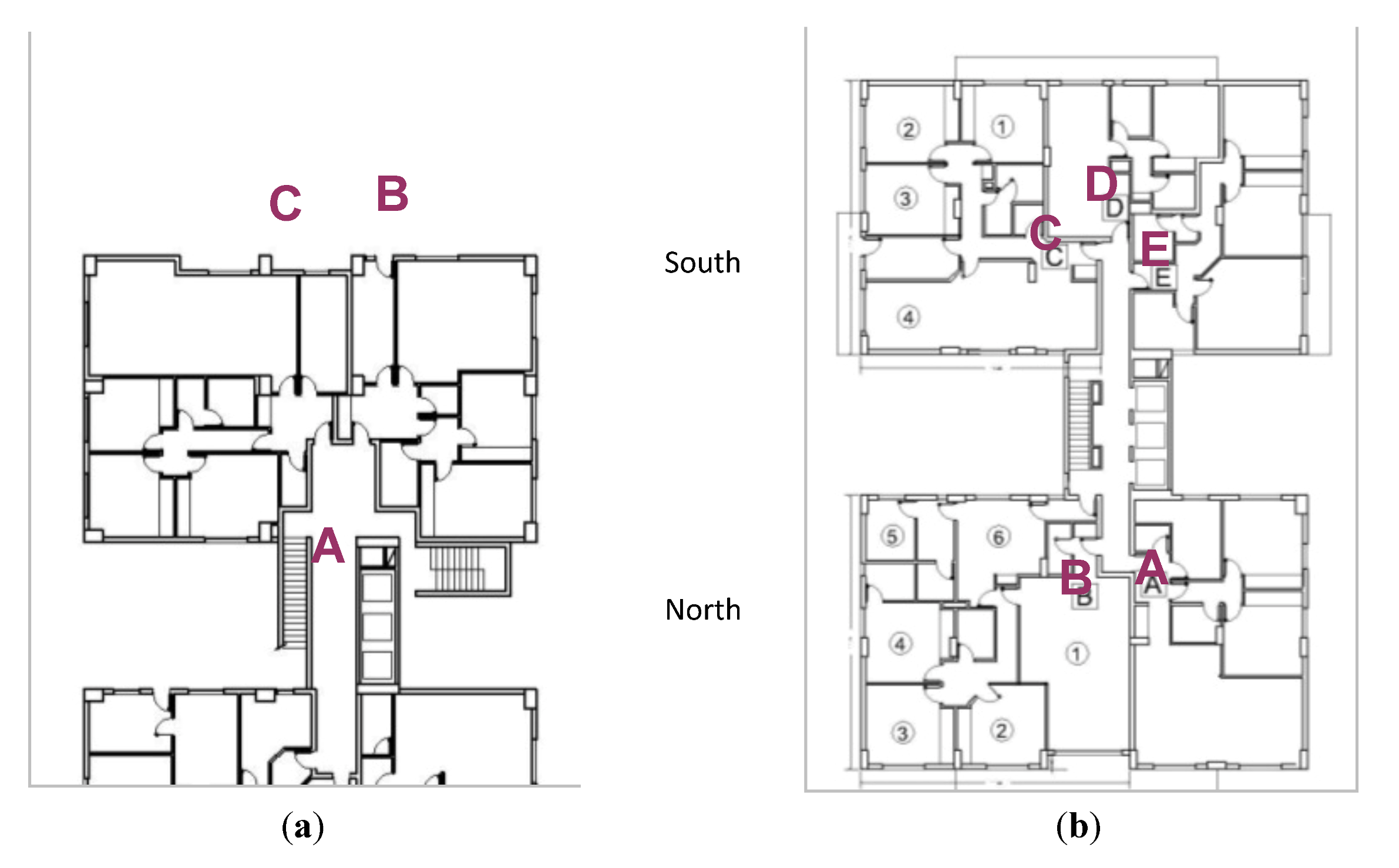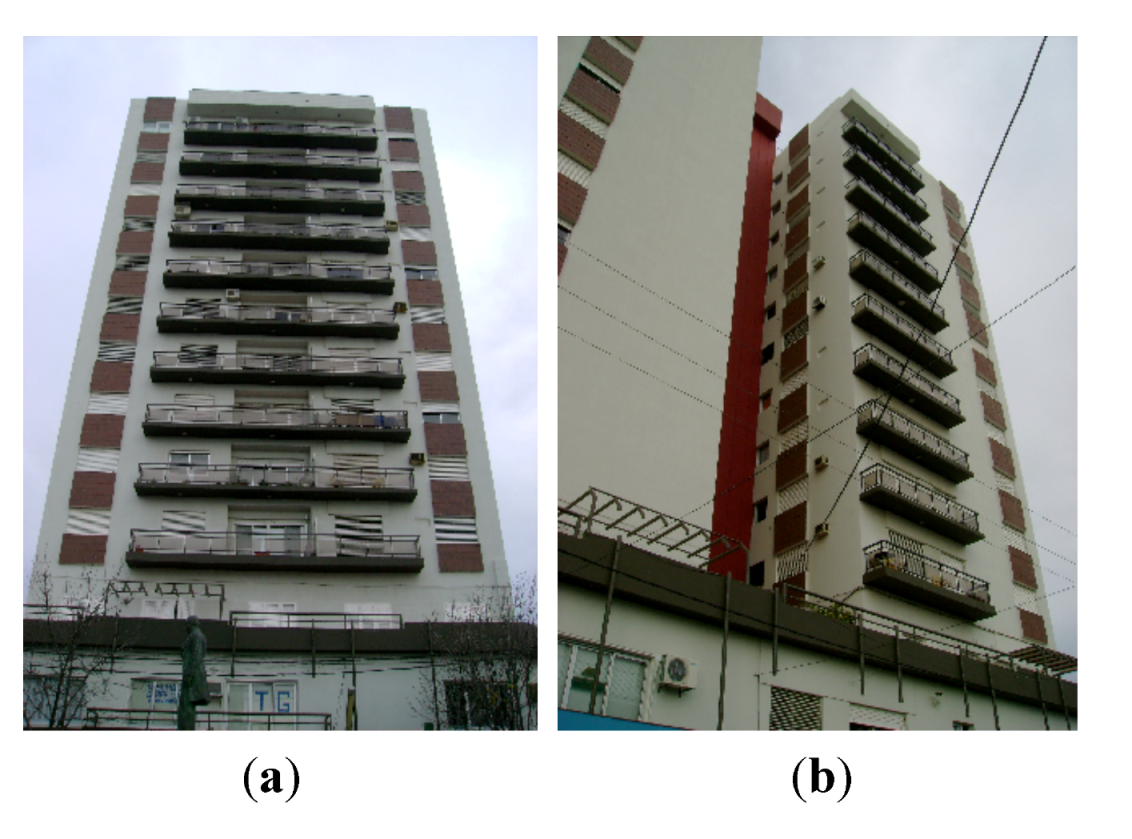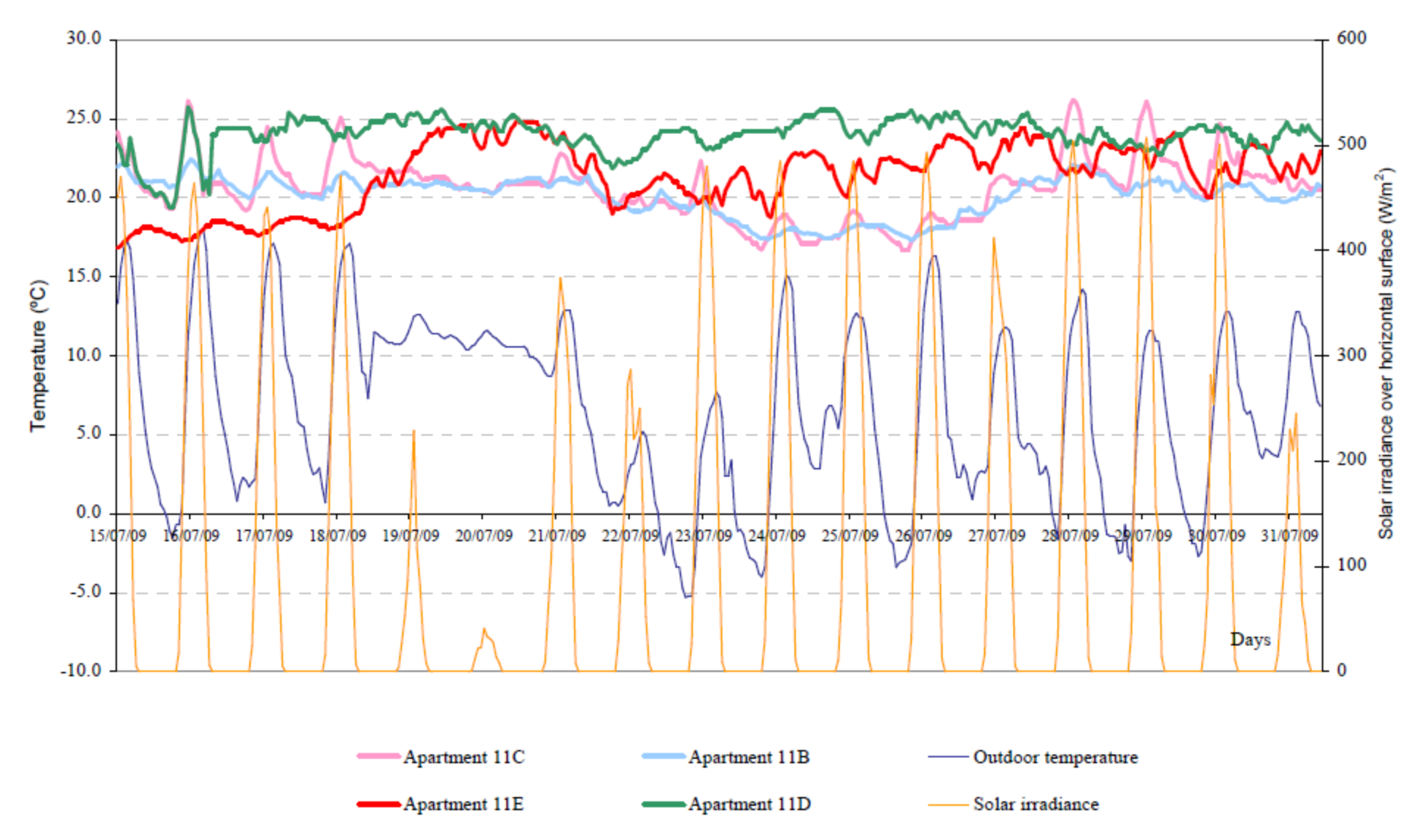2.1. Historical Natural Gas Consumption for Heating during the Period between 1996 and 2008
Table 3 shows the annual average natural gas consumption of 22 apartments, which total 41% of all apartments. The same table shows the standard deviation, the consumption variation coefficient among the studied years and the annual average historical consumption of natural gas destined exclusively to air heating. Only data from apartments whose records are uninterrupted and show little variability of the natural gas consumption among the study years were analyzed. This would assure the permanence of the same user in the apartment.
According to the average percentage estimated by the fluid distribution company, the 67% of the natural gas consumed in the study area is used to heat rooms [
46]. Considering this percentage, each apartment’s heating consumption was calculated on the basis of the gas recorded by each of them. Results show that natural gas historical annual heating consumption per m
2 of useful surface from the second to the top floor varied between a minimum of 59.0 kWh/m
2 (apartment 3C) and a maximum of 244.1 kWh/m
2 (apartment 9A). The sample average is 111.9 kWh/m
2, and the variation coefficient among apartments is 40.2%. The apartment located on the top floor (12E) consumes during the same period 176.3 kWh/m
2, which shows 60% more heating gas than the building’s average due to the higher energy losses through the roof without thermal insulation and a thermal transmittance around 3.82 W/m
2 °C, which is well above the Norma IRAM.
Variability among apartments’ consumption can be explained if, apart from the conditions of use, which are assumed to be different, other aspects are taken into account, such as orientation, shading provided by the North Block to the South Block—thus reducing solar recourse availability—and, also, heat transfer among the different apartments through the bordering walls and/or through the external envelope without insulation. In order to establish a comparison between the A, B, C, D and E apartments on all the floors, they were grouped, and both average and variability were calculated according to their orientation.
Table 3.
Average and variability of historical annual natural gas consumption and heating energy consumption estimated according to the percentage defined by the fluid distribution company (period: 1996–2008).
Table 3.
Average and variability of historical annual natural gas consumption and heating energy consumption estimated according to the percentage defined by the fluid distribution company (period: 1996–2008).
| Apartment | Gas total annual consumption (m3) [1] | CV (%) | Annual heating natural gas consumption. |
|---|
| 67% of [1]. 1 m3 = 8400 kcal |
|---|
| m3 | kWh | kWh/m2 |
|---|
| 2A | 3833.3 | 10.7 | 2568.3 | 25025.6 | 114.8 |
| 3A | 1175.2 | 11.5 | 787.4 | 7672.3 | 86.2 |
| 3B | 1580.8 | 13.9 | 1059.1 | 10320.2 | 80.0 |
| 3C | 940.2 | 14.9 | 629.9 | 6138.1 | 59.0 |
| 4A | 1812.7 | 15.7 | 1214.5 | 11834.2 | 133.0 |
| 4B | 2046.5 | 17.5 | 1371.2 | 13360.5 | 103.6 |
| 6B | 1378.8 | 12.0 | 923.8 | 9001.5 | 69.8 |
| 7E | 1442.4 | 10.4 | 966.4 | 9416.7 | 134.5 |
| 8C | 3146.3 | 10.9 | 2108.0 | 20540.6 | 197.5 |
| 8E | 1206.5 | 13.6 | 808.4 | 7876.6 | 112.5 |
| 9A | 3327.5 | 9.5 | 2229.4 | 21723.5 | 244.1 |
| 9D | 737.7 | 12.8 | 494.3 | 4816.1 | 102.5 |
| 10A | 834.8 | 20.4 | 559.3 | 5450.0 | 89.0 |
| 10B | 2069.6 | 12.8 | 1386.6 | 13511.3 | 104.7 |
| 10D | 964.5 | 10.4 | 646.2 | 6296.7 | 134.0 |
| 10E | 1259.2 | 15.6 | 843.7 | 8220.7 | 117.4 |
| 11A | 1707.7 | 16.7 | 1144.2 | 11148.7 | 125.3 |
| 11B | 1538.2 | 13.3 | 1030.6 | 10042.1 | 77.8 |
| 11C | 1005.5 | 15.6 | 673.7 | 6564.4 | 63.1 |
| 11D | 628.2 | 11.3 | 420.9 | 4101.2 | 87.3 |
| 11E | 1310.5 | 13.7 | 878.0 | 8555.6 | 122.2 |
| 12E | 1890.6 | 14.9 | 1266.7 | 12342.7 | 176.3 |
| Average | - | 111.9 |
| SD1 | - | 44.6 |
| CV2 | - | 40.2 |
Table 4 shows average consumption rates according to orientation. Apartment B, facing NE has the highest solar resource availability through its transparent area facing north in the living-room and two of the bedrooms; this apartment shows the lowest heating energy consumption/m
2. The highest consumption corresponds to apartment E, facing SW, strongly exposed to cold winds. Apartment D, facing south, has the least envelope surface in contact with the exterior area and shows 27.3% less energy consumption if compared to apartment E, the one with the greatest exposure to the exterior. Regarding the variation coefficient among floors, apartment D shows the lowest value (14.8%).
Table 4.
Average and variability of heating historical annual consumption (kWh/m
2) according to orientation. Period 1996–2008 (To see
Figure 3).
Table 4.
Average and variability of heating historical annual consumption (kWh/m2) according to orientation. Period 1996–2008 (To see Figure 3).
| Statistical indicators | Block north | Block south |
|---|
| A: facing to the northwest | B: facing to the northeast | C: facing to the southeast | D: facing to the south | E:facing to the southwest |
|---|
| Included 9A | Without 9A | Included 8C | Without 8C |
|---|
| Average | 127.4 | 104.1 | 87.2 | 109.0 | 58.0 | 121.0 | 161.0 |
| SD | 63.1 | 29.8 | 16.0 | 88.6 | 10.9 | 17.9 | 34.9 |
| CV | 49.5 | 28.6 | 18.3 | 81.3 | 18.8 | 14.8 | 21.7 |
Among the C apartments, the variation coefficient is 81.3%, which would be associated to the user’s thermal requirements (apartment 8C = 197.5 kWh/m2). Without the 8C apartment, the average descended to 58 kWh/m2 and the CV to 18.8%. The A apartments’ sample has a variation coefficient of more than 49.5% due to the high consumption in apartment 9A (244.1 kWh/m2). If it is not considered, the average and the CV drops to 101.1 kWh/m2 and 28.63%, respectively. These two apartments (8C and 9A) deserve an energy evaluation and thermal monitoring as special cases. It is necessary to know the evolution of indoor temperatures and the period of use of heating systems.
The apartment A, without apartment 9A, shows 16.2% more heating energy consumption than its neighboring apartment. Apartment A has less north solar gains availability, and it may be possible that there is heat transfer to apartment B. We assume that there is heat transfer among the units, for instance between apartment A and B, perhaps between D and E. It may be possible that apartments A and E, apart from their over-exposure to cold winds from the SW, may be releasing heat to the neighboring apartments, and consequently need more heating gas. The top floor consumed 59% more gas than the average heating gas consumed in the rest of the building.
Without 9A and 8C, apartment could be grouped in two blocks: North and South. Total consumption is 191.3 and 340 kWh/m2 for the North and South blocks, respectively. The South block consumed 78% more gas, a situation expected due to lower solar resource availability and greater vulnerability regarding strong and cold SW winds.
The analysis of gas historical consumption during July and August can be observed in
Table 5. The top floor consumed 87% more gas than the average heating gas consumed in the rest of the building (25.1 kWh/m
2).
Table 6 shows the historical average consumption during July, according to orientation. Including apartment 8C, apartment B, facing north and with the highest solar resource availability, shows the lowest value. The highest consumption value is that of apartment A, considering apartment 9A. Following the same pattern of annual consumption, we could say that there is heat transfer from apartment A to B, heat that would improve its thermal comfort conditions without increasing energy consumption. Apartment E shows the least natural gas historical consumption dispersion (CV = 4%) and one of the highest historical gas consumption/m
2, but not the highest, as occurred with the annual consumption. It is possible that due to its location, the heating period may extend longer.
Table 5.
Average and variability of historical heating gas natural consumption during July and August (period = 1996–2008).
Table 5.
Average and variability of historical heating gas natural consumption during July and August (period = 1996–2008).
| Apartment | July–August (m3) [1] | CV (%) | July (59.2% of [1]) |
|---|
| July (m3) [2] | Heating (75% of [2]) | kWh/m2 |
|---|
| (m3) | kWh 1 m3 = 8400 kcal |
|---|
| 2B | 1321.6 | 10.2 | 782.4 | 586.8 | 5717.7 | 26.2 |
| 3A | 433.3 | 13.9 | 256.5 | 192.4 | 1874.6 | 21.1 |
| 3B | 569 | 18.4 | 336.8 | 252.6 | 2461.7 | 19.1 |
| 3C | 349.4 | 13.6 | 206.8 | 155.1 | 1511.6 | 14.5 |
| 4A | 615.8 | 14.7 | 364.6 | 273.4 | 2664.2 | 29.9 |
| 4B | 731.4 | 16.1 | 433.0 | 324.7 | 3164.3 | 24.5 |
| 6B | 461.2 | 17.8 | 273.0 | 204.8 | 1995.3 | 15.5 |
| 7E | 521.6 | 14.4 | 308.8 | 231.6 | 2256.6 | 32.2 |
| 8C | 979.2 | 12.8 | 579.7 | 434.8 | 4236.3 | 40.7 |
| 8E | 389.4 | 17.7 | 230.5 | 172.9 | 1684.7 | 24.1 |
| 9A | 1077.8 | 9.4 | 638.1 | 478.5 | 4662.9 | 52.4 |
| 9D | 200.1 | 29.7 | 118.5 | 88.8 | 865.7 | 18.4 |
| 10A | 315.1 | 30.7 | 186.5 | 139.9 | 1363.2 | 15.3 |
| 10B | 702.1 | 12.3 | 415.6 | 311.7 | 3037.5 | 23.5 |
| 10D | 303.8 | 11.0 | 179.8 | 134.9 | 1314.3 | 28.0 |
| 10E | 412.2 | 17.3 | 244.0 | 183.0 | 1783.3 | 25.5 |
| 11A | 543.0 | 23.4 | 321.5 | 241.1 | 2349.2 | 26.4 |
| 11B | 331.4 | 18.5 | 196.2 | 147.1 | 1433.7 | 11.1 |
| 11C | 364.3 | 14.1 | 215.7 | 161.7 | 1576.1 | 15.2 |
| 11D | 202.5 | 24.7 | 119.9 | 89.9 | 876.1 | 18.6 |
| 11E | 434.1 | 13.3 | 257.0 | 192.7 | 1878.1 | 24.1 |
| 12E | 730.4 | 17.9 | 432.4 | 324.3 | 3160.0 | 45.1 |
| Average | 25.1 |
| SD | 10.3 |
| CV | 41.0 |
Table 6.
Average and variability of historical natural gas consumption to heating during July according to orientation in kWh/m2. Period 1996–2008.
Table 6.
Average and variability of historical natural gas consumption to heating during July according to orientation in kWh/m2. Period 1996–2008.
| Statistical indicators | Block North | Block South |
|---|
| A: facing to the northwest | B: facing to the northeast | C: facing to the southeast | D: facing to the south | E: facing to the southwest |
|---|
| Included 9A | Without 9A | Included 8C | Without 8C |
|---|
| Average | 28.6 | 23.8 | 20.7 | 27.6 | 14.9 | 21.7 | 24.8 |
| SD | 12.7 | 5.7 | 4.2 | 18.5 | 0.5 | 5.4 | 1.0 |
| CV | 44.6 | 23.9 | 20.3 | 67.0 | 3.2 | 25.1 | 4.0 |
Excluding 9A and 8C, and considering both blocks separately, the South block consumes 38% more heating gas than the North one. The difference between the two blocks decreased in relation to the historical annual consumption (78%), a situation that allows us to infer the potential of the use of the solar resource for heating the building, according to Givoni’s design strategies.
These two apartments (8C and 9A) deserve an energy evaluation and thermal monitoring as special cases in future research. Anyway, the variability of consumption during July in the period 1996–2008 is low. The records are: 12.8 and 9.4% for apartments 9A and 8C, respectively. These values could show that throughout the period, users maintain the same thermal conditions.









